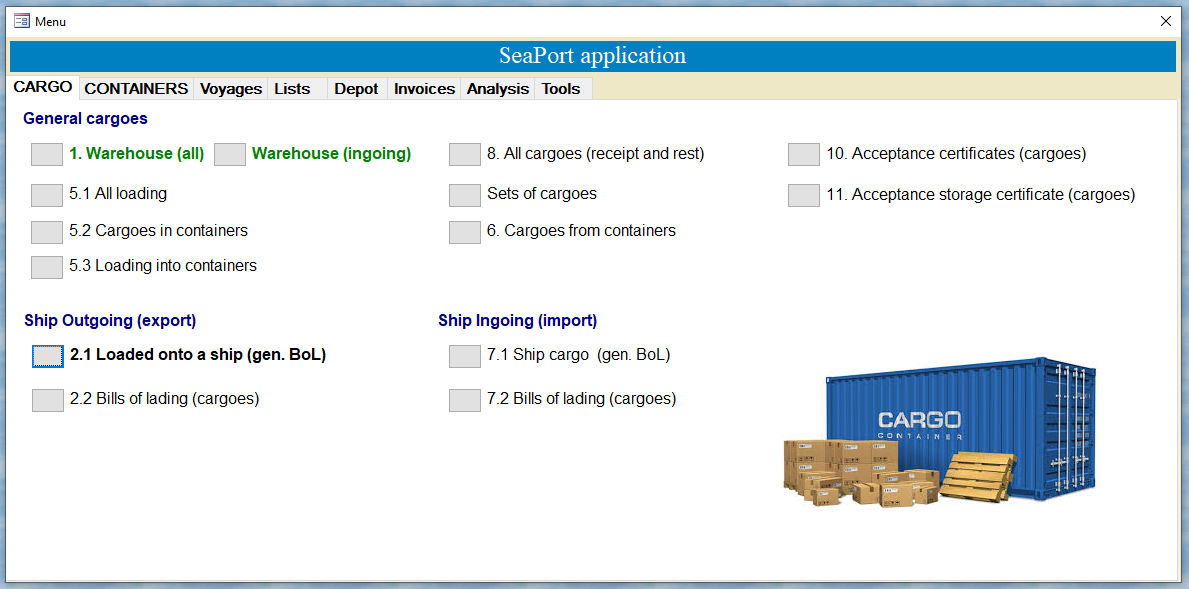The application (warehouse management system, WMS, terminal operating system, TOS) aims at freight forwarders, stevedoring companies, cargo transshipment complexes, dry ports, shippers, consignees, exporters and importers. It registers cargo and container loading / unloading operations at the sea or river port.
The application allows to keep track of diverse types of cargo (freight): containers, general cargo, machinery, equipment, bulk cargo, scrap, coal, etc.




DESCRIPTION:
It is worth noting that application allows to keep track of separation, normal wastage for each consignment for the scrap metal (ferrous metals) cargo. The application calculates itself normal wastage.
The cargo stored on the wharf "accumulates" storage. You can calculate the cost of such cargo storage for any period, for example, to send Invoice to the client. Cargo and container storage are obtained with a high level of degree of detail that provides clarity and easy accounting for your clients. The billing (Invoice) for the cargo loading and unloading or storage can be formed for the vessel on the whole or for different cargo operations.
The application holds a history of the cargo handling and storage for each consignment. You will not miss a single penny. In general, the application allows you to quickly calculate all the cost of cargo handling and storage.
When needed, you can open the company information and see all shipments associated with that counterparty. Thus, when a large amount of data, you can always quickly find everything in this application.
When the time comes to the moment of loading cargo on the vessel, the application allows you to quickly form a shipping order and the Bill of Lading and also, if necessary, the orders for these documents.
You can also print a certificate of consumption of materials (materials used for fixing of cargo in the vessel holds). The application helps to quickly create this document which contains a list of loaded cargo on the vessel and the list of materials consumed.
There is an additional possibility to print the certificate of sealing ship cargo holds.
It should say that all the data can be exported to a nice Excel reports.
Main features:
General Cargo Handling:
Cargo documents:

Container Handling:
Truck Parking Facility:
Finance:
frequently asked Questions
How to get started with the application?
Contact us with a request for the application. To demonstrate the work of the application, we will install the application together and show how to use it. The application will stay on your computer. You can use the application to know more about its capabilities. Further, to work with the application, you will need to buy it.
How much does the application cost?
The price of the application depends on the complexity of your workflow process and is calculated for each case.
How much does application maintenance cost?
We produce code so that everything works for years without problems. Therefore, minor problems can be fixed for free. If you need to add new functionality to the application, this usually happens on the basis of a new contract for upgrading the application. The price of all upgrades is subject to negotiation with the customer.
How much will it cost to tune the application for our requirements?
If you need to add new functionality to the application, this usually happens on the basis of a new contract for upgrading the application. The price of all upgrades is subject to negotiation with the customer.
What is the installation and implementation of the application?
It happens as follows: the customer becomes aware of the capabilities of the application. If the application is ready to use, then its working version is installed and work begins in the application. If some revision is required, such revision is carried out, for example, for a month or two and after that the application is ready to work. In the process, the application is still being improved and polished to become well-fledged.
Which documents are made for application purchasing?
License agreement (contract) on granting rights to use the application, invoice.


